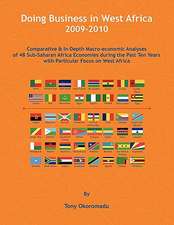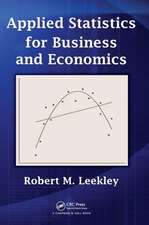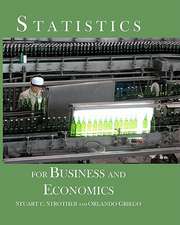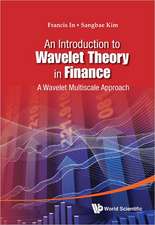Even You Can Learn Statistics and Analytics: An Easy to Understand Guide: Pearson Business Analytics Series
Autor David Levine, David Stephanen Limba Engleză Paperback – 20 iun 2022
THE GUIDE FOR ANYONE AFRAID TO LEARN STATISTICS & ANALYTICS UPDATED WITH NEW EXAMPLES & EXERCISES This book discusses statistics and analytics using plain language and avoiding mathematical jargon. If you thought you couldn't learn these data analysis subjects because they were too technical or too mathematical, this book is for you! This edition delivers more everyday examples and end-of-chapter exercises and contains updated instructions for using Microsoft Excel. You'll use downloadable data sets and spreadsheet solutions, template-based solutions you can put right to work.
Using this book, you will understand the important concepts of statistics and analytics, including learning the basic vocabulary of these subjects. Create tabular and visual summaries and learn to avoid common charting errorsGain experience working with common descriptive statistics measures including the mean, median, and mode; and standard deviation and variance, among othersUnderstand the probability concepts that underlie inferential statisticsLearn how to apply hypothesis tests, using Z, t, chi-square, ANOVA, and other techniquesDevelop skills using regression analysis, the most commonly-used Inferential statistical methodExplore results produced by predictive analytics softwareChoose the right statistical or analytic techniques for any data analysis taskOptionally, read the "Equation Blackboards," designed for readers who want to learn about the mathematical foundations of selected methods
Preț: 203.54 lei
Nou
38.95€ • 42.30$ • 32.72£
Carte disponibilă
Livrare economică 01-15 aprilie
Livrare express 15-21 martie pentru 37.88 lei
Specificații
ISBN-10: 0137654766
Pagini: 400
Dimensiuni: 180 x 228 x 32 mm
Greutate: 0.64 kg
Ediția:4 ed
Editura: Pearson Education (US)
Seria Pearson Business Analytics Series
Notă biografică
David M. Levine and David F. Stephan are part of a writing team known for their series of business statistics textbooks that include Basic Business Statistics, Business Statistics: A First Course, and Statistics for Managers Using Microsoft Excel. In long teaching careers at Baruch College, both were known for their classroom innovations, with Levine being honored with a Presidential Excellence Award for Distinguished Teaching Award and Stephan granted the privilege to design and develop the Colleges first computer-based classroom. Both are active members of the Data, Analytics and Statistics Instruction SIG of the Decision Sciences Institute.
Levine is Professor Emeritus of Information Systems at Baruch College. He is nationally recognized innovator in business statistics education and is also the coauthor of Applied Statistics for Engineers and Scientists Using Microsoft Excel and Minitab. Levine is also the author or coauthor of four books about statistical quality management: Statistics for Six Sigma Green Belts and Champions, Six Sigma for Green Belts and Champions, Design for Six Sigma for Green Belts and Champions, and Quality Management, 3rd Edition. He has published articles in various journals, including Psychometrika, The American Statistician, Communications in Statistics, Multivariate Behavioral Research, Journal of Systems Management, Quality Progress, and The American Anthropologist, and has given numerous talks at American Statistical Association, Decision Sciences Institute, and Making Statistics More Effective in Schools of Business conferences.
During his more than 20 years at Baruch College, Stephan devised techniques for teaching computer applications such as Microsoft Excel in a business context and developed future-forward courses that explored the effects of emerging digital technologies. He also served as the associate director of a U.S. Department of Education FIPSE project that successfully integrated interactive media into classroom instruction for the humanities.. Stephan is also the developer of PHStat, the statistics add-in for Microsoft Excel distributed by Pearson Education.

















